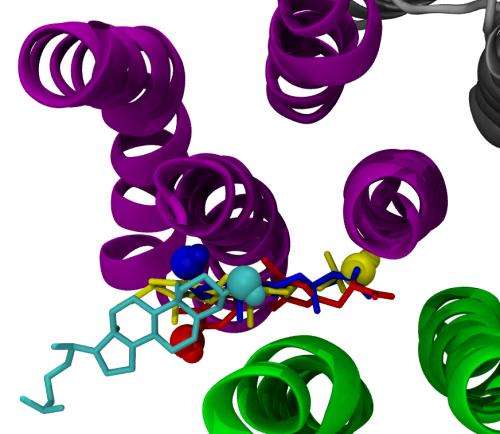Research could lead to advances in treatment for neurological disorders, thyroid cancer

An innovative research project at Rutgers–Camden that combines computational and experimental science is uncovering information that could lead to advances in treatments for neurological disorders and thyroid diseases.
To solve the puzzle, Rutgers–Camden professors Grace Brannigan and Joseph Martin are studying a protein fundamental to our understanding of the brain: the GABA(A) receptor.
"We're trying to determine the mechanism through which natural compounds—neurosteroids and thyroid hormones—interact with the GABA(A) receptor," says Brannigan, an assistant professor of physics in Rutgers–Camden's Center for Computational and Integrative Biology at Rutgers–Camden.
GABA is an inhibitory chemical that blocks impulses between nerve cells in the brain. A GABA(A) receptor's job is to detect and respond to GABA. GABA(A) receptors are also regulated by neurosteroids, made from cholesterol, that impact behavior, stress, memory, and depression; and thyroid hormones that also affect these brain functions.
"Without a constant inhibitory effect on the brain, you could have problems like anxiety or seizures," says Martin, a professor of biology who directs the Center for Computational and Integrative Biology.
The mystery surrounds how neurosteroids and thyroid hormones work with the GABA(A) receptor. Finding the answer could lead to drug treatments for thyroid diseases, anxiety disorders, and even learning how anesthetics work.
"We want to have a picture of what it looks like when the molecule [GABA] binds to the protein [GABA(A)]," explains Brannigan, who is predicting how they interact with each other using computer modeling. Her calculations are being made on sophisticated computers on the Rutgers–Camden campus and through the National Science Foundation's XSEDE supercomputers, which support high-end visualization and data analysis resources across the country.
Meanwhile, Martin is testing predictions about where the binding takes place by observing the response of immature frog egg cells which are made to express GABA(A) receptors.
"We're doing this high-performance simulation to determine how the two interact and where the interaction takes place," Brannigan says. "People have been trying to develop drugs that mimic these natural neurosteroids and hormones, but the synthetic versions don't seem to have the effect you'd hope."
The research could lead to an understanding of how the neurosteroids interact with the receptor, which would then impact various treatments for neurological disorders.

















